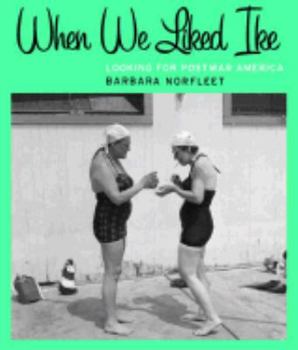When We Liked Ike: Looking for Postwar America
After World War II, the prevalent self-image among America's white middle class was one of affluence, moral superiority, and contentment. This image is reflected in photographs in both advertising and the media during the late 1940s and 1950s showing perfect citizens and their families at work and at play. Many of these apparently candid photographs were in fact created by professional studio photographers--to portray the way most middle-class Americans wanted to present themselves. But what many contemporary artists and intellectuals saw instead of this idyllic picture was widespread complacency and conformity, as well as racism, poverty, political witch hunts, and alienation. Their writings are excerpted here, juxtaposed with images depicting domestic bliss and wealth. This dissonance between the words of the social critics who emphasized our problems and discontents and the photographic images of how we wanted to see ourselves make the subsequent upheavals of the 1960s understandable.
Format:Hardcover
Language:English
ISBN:0393019667
ISBN13:9780393019667
Release Date:May 2001
Publisher:W. W. Norton & Company
Length:159 Pages
Weight:1.98 lbs.
Dimensions:0.7" x 8.8" x 10.4"
Customer Reviews
3 ratings
Wonderful photos but...
Published by Thriftbooks.com User , 15 years ago
What I found strange about this book was the lack of information about the individual photos. Many simply say "n.d" and nothing else, since obviously there was little available. But this leaves the reader in the dark, especially since the text is primarily a series of quotes from various writers (i.e. Vance Packard, David Riesman, etc.) which are very interesting, since they comment in some sense on the photos, but this still leaves the more specific background missing. I would have loved to know who the people were, where the photo was taken--anything to fill in those blanks. I realize that may not have always been possible, but it was frustrating nonetheless. That said, the reproductions and the selections are really nice in this book. It actually reminds me in some ways of Michael Lesy's strange masterpiece "Wisconsin Death Trip", in that it's a sort of collage of text and photo. But this time it's post-war America rather than late 19th-century Wisconsin.
An artificial depiction of life in America after World War II
Published by Thriftbooks.com User , 18 years ago
The fifteen years between the end of the Second World War and 1960 are years that are often portrayed as idyllic. America was supreme in the world, television was in its infancy and a harbinger of technological progress and most of the photographic record was one of happy people, lifelong and sound marriages and children who behaved. The reality was far different. Many of the housewives were suffering from extreme angst, a large number of the returning soldiers were suffering from what is now known as Post-Traumatic Stress Disorder (PTSD), there was paranoia over the Communist threat, segregation was nearly universal, and there was enormous social pressure to conform. This book is a collection of photos that depict America as described in the first paragraph. Very few of the photos display a non-Caucasian face and only one shows a black family in their home. There are photos of the latest household appliances, new cars and the growing suburban sprawl. Smoldering cigarettes are in the hands of many of the men and a few of the women. In looking closely at the photos, few of the people appear to be really happy. There are smiles, but not the kind that project joy. The author is very forthright in the introduction, explaining that these photos were deliberately designed to show an idyllic environment. To look at them, you would not realize that there were many people living in dire poverty. It appears that everyone got along, while there is mention of political tension in the captions you cannot see it in the photos. While the photos are of excellent quality, there is a certain artificial nature to the life that is depicted. In many ways, there is a great deal of "just faking it."
A middle class flashback.
Published by Thriftbooks.com User , 22 years ago
Barbara Norfleet concentrates on a rather under-appreciated aspect of American photography, the local commercial photo studio found in most towns across the country. This book is an extension of her first book `The Champion Pig', which examined studio photography from 1929 to 1960. `When We Liked Ike', with 170 excellent photos, covers the years from 1945. The author explains how these photos were taken to please those who commissioned them and they basically show the attitudes, values and aspirations of the white middle class. There are plenty of family gatherings and social events but also examples of outdoor commercial activity, the Florida studio of Joe Steinmetz produced excellent architectural work like the drive-in hamburger unit on page 126. Nearly every photo is worth studying for the detail they contain, they are not blurred, grainy or gimmicky, this is a record of what the subject wanted (and paid for) not how the photographer felt about the subject. The only details provided about the images are the photographer's name and sometimes a date, this lack of information can be annoying at times, page eighty-seven shows a woman smoking a pipe, her head surrounded by smoke, just why did Jack Gould take this picture in 1946? Page thirty-three shows a (pin-sharp) photo of a traffic jam in Main Street, Somewhere USA, why was this moment captured for ever? The book is well designed and printed though I think the cover design is unimaginative and the photo (two senior citizens in swimwear enjoying a smoke) rather inappropriate to sum up post-war America. As well as the fascinating `The Champion Pig', `Wedding' is another Barbara Norfleet book using work of the local studio photographer. ***FOR AN INSIDE LOOK click 'customer images' under the cover.






